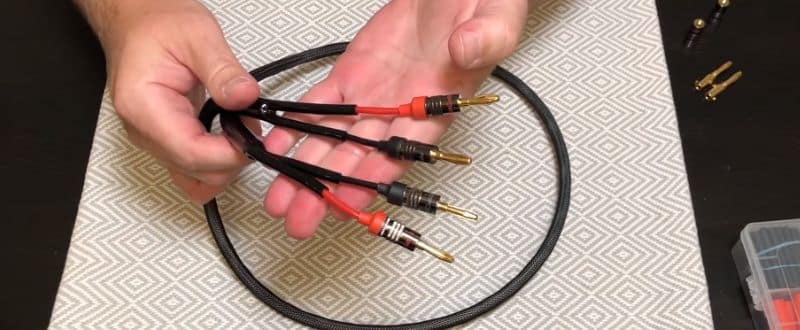One of the most asked questions I have been bombarded with is, what is the right speaker wire for car audio?
The answer is not absolute as it varies upon individual needs and system requirements. My comprehensive car speaker wire guide will solely focus on answering that question.
Choosing the right speaker wire depends on several factors like desired gauge, budget, distance of installation from source, etc. Now, I will broadly explain each factor one by one.
In This Article
What Gauge Speaker Wire Do You Need for a Car Speaker?
Before I speak about what a gauge is, always remember that the lower the gauge number, the better and thicker the gauge is.
Determining the speaker gauge is crucial for selecting the right speaker cable. Gauge is the measure of the wire's thickness, and it plays a huge role in determining how much resistance it offers and the amount of electric current it can handle.

Generally, I recommend having either 14, 16, or 18-gauge speaker wires for your speakers according to your system requirements. On the other hand, 12, 14, or 16-gauge speaker wires are advisable for your subwoofers according to your system.
I also recommend you avoid extreme gauge sizes like 8 or 10 gauge as they are very expensive and their large thickness makes them hard to bend. Again, extremely large gauge-numbered wires like 20 or 22 are too thin to handle your power demands.
Quick Guide: Speaker Wire Gauge Size
For your ease of your understanding, I have jotted down some key rules. These key rules will help you in choosing the perfect gauge size for your vehicle’s audio system.
Considering RMS Power for Gauge Size
- For systems up to 50 watts RMS per channel, 16-gauge wire is usually sufficient.
- For systems between 50-100 watts RMS per channel, 14-gauge wire is more appropriate.
- For systems over 100 watts RMS per channel, you might need 12-gauge or even 10-gauge wire, especially for longer wire runs.
Considering Wire Run for Gauge Size
Longer wire runs require thicker gauge wire to prevent signal loss.
- Less than 50 feet: 16 gauge
- 50 to 100 feet: 14 gauge
- Over 100 feet: 12 gauge
Check out Step 3 of the Wire length section of the article to get a more comprehensive idea.
Considering Speaker Impedance for Gauge Size
Lower impedance (measured in ohms) requires a thicker wire to ensure adequate power is delivered.
- 8 ohms: You can typically use thinner wire.
- 4 ohms: Thicker wire is often necessary.
Aiming for Optimum Resistance
Thicker wire means more current can flow through the cable with less resistance. This is because a thicker wire has more area for the electric current to flow through, reducing the obstacles to the current. Conversely, a thinner wire (higher gauge) has higher resistance due to its smaller cross-sectional area. Though, “the thicker the better” goes without saying, thicker wires are more expensive.
High resistance in speaker wires can lead to signal loss and degrade the sound quality. This is more noticeable in longer wire runs or with higher power systems. Using a thicker wire (lower gauge) in these scenarios ensures minimal resistance, preserving the quality and strength of the audio signal.
The Right Type of Car Speaker Wire
While deciding on the cable’s material, you have two options. Either Oxygen-Free Copper (OFC) Wires or Copper Clad Aluminum (CCA) Wires.
Oxygen-Free Copper (OFC)
OFC wires are made from refined copper that has a reduced level of oxygen content (typically below 0.001%). This high purity level enhances its conductivity by minimizing signal loss and ensuring that the audio signal is transferred efficiently from the source to the speakers. They will perfectly complement your high-fidelity music systems.
Also, OFC cables are less likely to catch oxidation and corrosion. It is beneficial in the regions where the environment induces humidity.

OFC wires are typically more flexible and durable. This flexibility is advantageous for car installations, which often require cables to bend around tight corners and fit into narrow spaces.
The main drawback of OFC wires is their cost. They are generally more expensive than CCA wires, reflecting their higher quality and performance capabilities.
Copper Clad Aluminium (CCA)
These wires are lighter and more affordable than OFC wires. The lower cost makes them a popular choice for budget-conscious car audio enthusiasts or for systems where absolute audio fidelity is not the primary concern. It has an aluminum core coated with a thin layer of copper which is the main reason for its reduced cost.

Because of their high resistance, they are not as efficient as the OFC wires, especially over longer distances.
They are generally stiffer and less durable than OFC wires. They can be more susceptible to breaking during installation, which could be a consideration if you need to route wires through complex paths in your vehicle.
What Colour Speaker Wire Should You Get?
First of all, color has nothing to do with your speakers’ performance. You should consider it only for your ease of installation and organization.
The main reason for distinct cables is to distinguish between positive and negative cables. This distinction helps ensure that you connect the speakers correctly, maintaining the proper polarity and avoiding potential audio quality issues.
While there's no universal standard for speaker wire colors, many manufacturers use certain common schemes. For example, a very common design is red for the positive (+) conductor and black/blue for the negative (−) conductor.
I advise my readers to maintain consistency throughout the system to avoid confusion and errors. For instance, if you start with red as positive for one speaker, maintain that for all the speakers.
What should be the Length of Your Car Speaker Wire?
Determining the appropriate length for your car speaker wire is crucial, as inaccurate measures will lead to operational and installation difficulties, and a longer wire means bigger payments.
Now, let me see how to determine the appropriate length for speaker wires in 2 simple steps.
Step 1: Measure the Distance
You may use a measuring tape or wire too measure the distance from your audio source like the stereo or amplifier, to each speaker. Also, do not forget to include the zig-zag path the wire will take in the car. This will give you a basic idea of the wire length needed for each speaker.
Step 2: Add Extra Length for Safety
It's wise to add some extra length to your measurements to account for any unforeseen obstacles or rerouting. Typically, adding an extra 10-15% is a good rule of thumb. This extra length also allows for easier handling and adjustments during installation.
But do not keep a lot of excess slack, which can be problematic. Excess wire can get tangled, making the installation look messy. Longer wires can induce signal loss, especially in the case of smaller gauged wires. For longer runs, consider using a thicker gauge wire to ensure signal integrity.
Step 3: Wire Run According to Gauze Size
Gauge and your length of the wire is directly related for obvious reasons. There are too many variables to account for and that makes it inaccurate to give a generalized guideline or wire length chart. Though I have provided a chart for you to get an estimated idea, I suggest you consult with a professional or refer to the manufacturer's recommendations for your specific components.
These charts were inspired by soundcertified.
Copper Speaker Wire Chart
Wire AWG | 2Ω Speaker | 4Ω Speaker | 6Ω Speaker | 8Ω Speaker | 16Ω Speaker |
|---|---|---|---|---|---|
18 | 9ft (2.8m) | 18ft (5.6m) | 28ft (8.4m) | 37ft (11.2m) | 73ft (22.4m) |
16 | 12ft (3.6m) | 23ft (7.2m) | 35ft (10.7m) | 47ft (14.3m) | 94ft (28.7m) |
14 | 20ft (6.2m) | 40ft (12.3m) | 61ft (18.5m) | 81ft (24.7m) | 162ft (49.4m) |
12 | 31ft (9.4m) | 62ft (18.9m) | 93ft (28.3m) | 124ft (37.8m) | 248ft (75.5m) |
Copper Clad Aluminium (CCA) Wire Chart
Wire AWG | 2Ω Speaker | 4Ω Speaker | 6Ω Speaker | 8Ω Speaker | 16Ω Speaker |
|---|---|---|---|---|---|
18 | 7ft (2m) | 13ft (4.1m) | 20ft (6.1m) | 27ft (8.2m) | 54ft (16.3m) |
16 | 9ft (2.6m) | 17ft (5.2m) | 26ft (7.8m) | 34ft (10.5m) | 69ft (20.9m) |
14 | 15ft (4.5m) | 30ft (9m) | 44ft (13.5m) | 59ft (18m) | 118ft (36m) |
12 | 23ft (6.9m) | 45ft (13.8m) | 68ft (20.7m) | 90ft (27.6m) | 181ft (55.1m) |
The Best Connector for Speaker Wire
While purchasing your speaker wire, you will also be required to choose some connectors. More often, customers choose the wrong connector type which is not compatible with their wire gauge, type of car speaker, or the amplifier.

Car Speaker Connectors Types
While selecting the connectors, you will have to select among 13 popular options and make sure they are compatible with your speaker cables.
They are bare wire, banana plugs, spade connectors, pin connectors, speakon connectors and Etc. There are many more nuances and options when it comes to car speaker wire connectors. It is important to select the right connector type for your speaker wire for longevity and security.
The End
Now, that you know all the elements for determining the speaker wire size, you are ready for installation.
Be careful of circuit breaks and hazards during installation. My last advice is to check for proper wire size and make sure that they are compatible with the speaker connectors.
Now you know every necessary step for selecting the most compatible wire for your speaker. If you want to find the perfect speaker for yourself, then give a read to our car speaker buying guide.
Articles You May Read:

